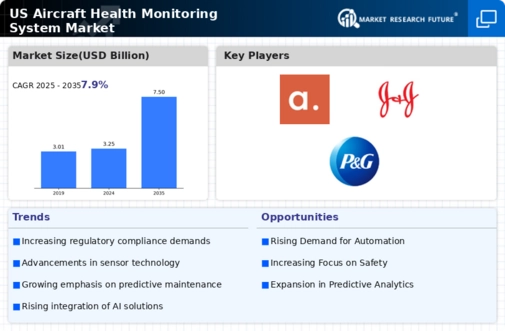Growing Demand for Fuel Efficiency
In the aircraft health-monitoring-system market, the increasing emphasis on fuel efficiency is a significant driver. Airlines are under constant pressure to reduce operational costs, and fuel represents a substantial portion of these expenses. By implementing advanced health-monitoring systems, operators can optimize engine performance and reduce fuel consumption. Studies indicate that effective monitoring can lead to fuel savings of up to 5%, which translates into millions of dollars in savings annually for large airlines. This focus on fuel efficiency is likely to drive the adoption of health-monitoring systems, as operators seek to enhance their competitive edge in a challenging market.
Expansion of the Commercial Aviation Sector
The expansion of the commercial aviation sector in the US will drive growth in the aircraft health-monitoring system market. As air travel demand continues to rise, airlines are investing in modernizing their fleets, which includes the integration of advanced health-monitoring systems. This trend is particularly evident in the regional and low-cost carrier segments, where operational efficiency is critical. The market is projected to benefit from this expansion, with estimates suggesting that the number of aircraft equipped with health-monitoring systems could increase by 20% by 2030. This growth reflects the industry's commitment to leveraging technology for enhanced performance and reliability.
Increased Focus on Safety and Risk Management
Safety remains a paramount concern in the aviation industry, driving growth in the aircraft health-monitoring-system market. Airlines are increasingly adopting comprehensive risk management strategies that incorporate advanced monitoring systems to identify potential issues before they escalate. This proactive approach to safety not only protects passengers but also enhances operational reliability. The market is likely to see a rise in demand for systems that provide detailed insights into aircraft health, as operators aim to mitigate risks associated with mechanical failures. This focus on safety could lead to a market growth rate of around 7% annually over the next five years.
Regulatory Pressures and Compliance Requirements
The aircraft health-monitoring-system market is influenced by stringent regulatory pressures and compliance requirements. Regulatory bodies in the US mandate that airlines adhere to rigorous safety standards, which necessitate the implementation of effective monitoring systems. Compliance with these regulations not only ensures passenger safety but also helps airlines avoid costly penalties. The market is expected to expand as operators invest in health-monitoring systems to meet these evolving regulatory demands. As of 2025, it is estimated that compliance-related investments could account for approximately 15% of total expenditures in the aircraft health-monitoring-system market.
Technological Advancements in Monitoring Systems
The aircraft health-monitoring-system market is experiencing a surge due to rapid technological advancements. Innovations in sensor technology, data analytics, and machine learning are enhancing the capabilities of monitoring systems. These advancements allow for real-time data collection and analysis, which is crucial for predictive maintenance. The market is projected to grow at a CAGR of approximately 8% from 2025 to 2030, driven by the need for improved operational efficiency and reduced downtime. As airlines and operators increasingly recognize the value of these technologies, investments in advanced monitoring systems are likely to rise, further propelling the aircraft health-monitoring-system market.














Leave a Comment